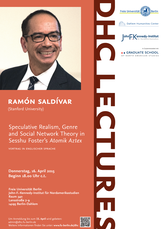 |
Sesshu Foster’s Atomik Aztex (2005) is perhaps the wildest example of contemporary American novels concerned with the relationships among race, form, genre, representing what Jeffrey T. Nealon has recently termed the “post-postmodern.” Part fantasy, part hallucinatory sur-realism, part muckraking novel in the grand realist protest tradition of Upton Sinclair’s The Jungle (1906), part historical novel in the mode of Vassily Grossman’s great Stalinist era masterpiece, Life & Fate (1980) set during the battle of Stalingrad, part ethnographic history about religious, military, and social structure of the pre-Columbian Aztec (Nahua, Mexica) world, part LA noir, and wholly Science Fiction alternative and counterfactual history, it exemplifies many of the criteria of the “post-postmodern.”
Moreover, in addition to this range of formal matters, Atomik Aztexis concerned with two other topics:
- a reconceptualization of the way that race affects the formations of history, and
- the reshaping of the form of the novel in order to represent that reconceptualization.
With eighty-two characters populating the story, itself a plotted compendium of at least two radically separate yet intertwined universes of action, in a continually shifting movement from past, present, and future times, Atomik Aztex is a radical experiment in novelistic form. Using the tools of quantitative formalism developed for literary use by the Stanford University Literary Lab, I wish to show how the work of the computational humanities, in conjunction with traditional hermeneutic methods of literary analysis can help us understand the radical turn of contemporary American fiction toward speculative realism.
In Zusammenarbeit mit:
 |